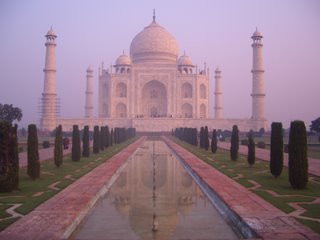Shopping in Varanasi : the silk city !Silk weaving is perhaps the most popular art of Varanasi.
The shopping hotspots in Varanasi are Chowk, Gyan Vapi, Vishwanath Gali, Thatheri Bazar, Lahurabir, Godoulia or Dashswamedh Gali and Golghar. Besides the illustrious and fine silks and brocaded fabrics, one can also buy shawls, carpets, wall hangings...
When you enter a silk shop, the owner will offer you a masala tea and then he will show you all the silk scarfs he has in his shop ! All of them are very colourful, you can't even choose one because there are so many different styles, colours, sizes... It's like the 1001 nights or Alibaba palace. Completely amazing !

Ganges baths

Very early in the morning, at about six o'clock, hindu people take their bath in the Ganges river to purify themselves. This bath is a spiritual act with special rites.
Ganges river to purify themselves. This bath is a spiritual act with special rites.
It will purify the soul from sins and is an important step on the way to an ultimate goal - the Nirvana, which means the salvation from the cycle of birth, death and rebirth and ultimately to be one with the almighty God, the creator.
Varanasi also is a favorite place to die, for hindus believe, that one who dies at Varanasi gains emancipation automatically, such is the greatness of this shrine! That's why there are ritual cremations on pyres from Sandle wood and in crematoria each night. All hindus desire, that no matter where they die, at least their ashes be merged in the pious waters of mother Ganga who in Hindu's belief in her immense love for her children will bring emancipation from the trauma of the cycle of birth and death!

The PUJA

 Every evenings, Hindu people perform the "Puja" with lighted lamps.
Every evenings, Hindu people perform the "Puja" with lighted lamps.
They offer candles to the Ganges while musicians are playing music and siging holy words.
The ambience is spectacular and very spirituous.
 Sarnath is the city where Buddha preached his first discourse in the deer park to set in motion the 'Wheel of the Dharma'. It is one of the most holy sites as in this place the stream of the Buddha's teaching first flowed.
Sarnath is the city where Buddha preached his first discourse in the deer park to set in motion the 'Wheel of the Dharma'. It is one of the most holy sites as in this place the stream of the Buddha's teaching first flowed. 
 Varanasi is one of the oldest cities in the world : more than 3000 years old.
Varanasi is one of the oldest cities in the world : more than 3000 years old.
It is a Holy and worship place for Hindu people : same as the Vatican for the Catholics or the Mecca for the Muslims. Moreover, this city is THE one which reflect the most the real Indian culture and the power of Hinduism.
Every year, more than one million pilgrims come to have a bath in the Ganga.
 It is believed by Hindus that bathing in the river Ganga results in remission of sins and that dying in the holy city of Kashi (Varanasi) circumvents rebirth.
It is believed by Hindus that bathing in the river Ganga results in remission of sins and that dying in the holy city of Kashi (Varanasi) circumvents rebirth.

Walking on the ghâtsWalking on the Ganga ghâts, we met different people having a bath, cleaning and drying their clothes. The atmosphere is very quiet and peaceful.

 The Clock Market
The Clock Market
The clock tower is the central point of Jodhpur.
There is a big market standing around the clock : spices, fruits & vegetables, clothes, varieties of seeds (corn, lentil, rice...) & lots of other things... The tower was built in 1910 by Maharajah Sardar to give the time to inhabitants. That's why the market is called the Sardar Market.


Umaid Bhawan Palace
We also visited the Umaid Bhawan Palace where the Maharajah of Jodhpur is living at the moment. This monument has got three different parts :
1- The Maharajah & his family house
2- A Palace Hotel part of Taj Resort which is a famous Indian Hotel Brand all over the country.
3- The museum

Having fun in the small blue streets of the old city
We met very nice indian people walking in these very tight streets.
We also had Masala tea with old men and tried to discuss with them because they couldn't speak english.
Masala tea is the most popular drink in India. It's tea with milk, cardamon & ginger. First, you boil the milk twice, then you had Chai tea, the spices and sugar. This is a very good hot drink and you can find it wherever you want.

Temples
On the way to Osian, a small town near Jodhpur in the desert, we visited Hindu and Jain temples.


The desertIn Osian desert, we had a fun camel ride et just looked at the beauty of such a landscape.



The Camel Camp

Then, after the ride, we took a break in an oasis lost in nowhere in the desert called the camel camp. We had a nice lunch and rested in this beautiful and luxuous place.


We arrived in Jodhpur at about 10 in the morning.
A driver took us at the station and we went to our Hotel Ratan Villas.
It was a nice colonial house built in the 1920s.
The owners were very kind and they were the fifth generation living in this house.
Mehrangarh Fort or the Citadel of the Sun
 Then, we decided to visit the fort. It was constructed in 1459 like a real eagle nest by the founder of Jodhpur: rao Jodha who gave the name of Jodhpur. The fundation is dominating the town at 135 meters above the city ; its width is 250 meters.
Then, we decided to visit the fort. It was constructed in 1459 like a real eagle nest by the founder of Jodhpur: rao Jodha who gave the name of Jodhpur. The fundation is dominating the town at 135 meters above the city ; its width is 250 meters.
Mehrangarh (meaning Majestic Fort) is one of the largest forts in India.
Maharajahs lived there until the 20th century and then go the Umaid Bhawan Palace (I will talk about it later).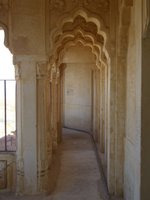
Battle scars of canon ball hit by attacking armies of Jaipur can still be seen on the second gate. To the left is chhatri of Kirat Singh Soda, a soldier who fell on the spot while defending the fort against the armies of Amber.
There are seven gates, which include Jayapol meaning victory built by Maharaja Man Singh to commemorate his victories over Jaipur and Bikaner armies. Fattehpol also meaning victory gate was built by Maharaja Ajit Singh to mark the defeat of Mughals. The palm imprints still attract devotional attention and are covered by vermilion paste and paper-thin silver foil.
We took the audio guide to have the whole story of this fort.
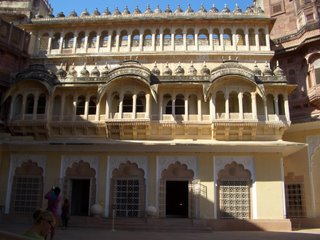
The blue city
Jodhpur is the second largest city in the Indian state of the Rajasthan. Jodhpur is a popular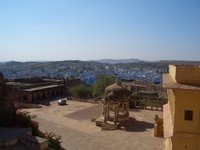 destination, featuring many beautiful palaces, forts and temples, apart from a stark, scenic desert landscape. The city is known as the "Sun City" for the bright, sunny weather it enjoys all year. It is also referred as the Blue City, due to the indigo tinge of the whitewashed houses around the Fort. Jodhpur is also known for gentleness of its people. The old city of Jodhpur is surrounded by a thick stone wall. The wall has six huge gates called Nagauri gate, Merati gate, Sojati gate, Jalori gate, Siwanchi gate and Chand pol.
destination, featuring many beautiful palaces, forts and temples, apart from a stark, scenic desert landscape. The city is known as the "Sun City" for the bright, sunny weather it enjoys all year. It is also referred as the Blue City, due to the indigo tinge of the whitewashed houses around the Fort. Jodhpur is also known for gentleness of its people. The old city of Jodhpur is surrounded by a thick stone wall. The wall has six huge gates called Nagauri gate, Merati gate, Sojati gate, Jalori gate, Siwanchi gate and Chand pol.

On the way to Jodhpur
We had a 4 day week-end from Thursday night to Tuesday morning...
So we decided to go far away in the Rajasthan. We took the night train at Old Delhi Station in category 3 AC (that means the 3rd class with Air Conditionning).
Indian trains have 5 different categories : First, Second AC, Third AC, sleeper and general.
It is funny because the names are written on a paper and you have to check your when you get in the train. In our coach, there were 6 + 2 beds. It's enough comfortable: you have cloths, blanquets & pillow.
We had a nice dinner: we brought a "saucisson sec", some olives, crisps and fresh vegetables.

 On wenesday afternoon, we had the opportunity to
On wenesday afternoon, we had the opportunity to  visit an Indian plant : Hero Honda.
visit an Indian plant : Hero Honda.
In a little over two decades, the world's largest manufacturer of bicycles and the global leader in motorcycles have created not only the world's single largest motorcycle company but also the most endearing and successful joint venture for Honda Motor Company worldwide.
They manufacture 6500 motorcycles every day : one bike is made every 3 seconds ! It was really interesting to see the assembly line which is very modern and has great technologies.
Jaipur
Notre dernière journée à Jaipur a été pleine d'émotions. Nous avons repris notre taxi pour aller visiter la ville et le palais du Maharajah de Jaipur. Mais l'ennui, c'est qu'à peine installer dans la voiture, notre chauffeur sentait l'alcool et été complètement à l'ouest. Et pour couronner le tout, nous avons eu un mini accident avec l'autre chauffeur qui nous suivait avec 4 potes en plein milieu d'un énorme rond-point où tout le monde klaxonnait, criait !!! La foire !! Les flics étaient là... Constat, perte de temps et compagnie...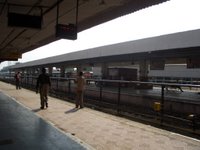
Nous avons dû prendre une rapide décision pour la suite vu que nous avions déjà perdu 1h30 avec tout ce cinéma. Nous avons choisi de payer notre taxi driver et de nous rendre le plus vite possible à la gare pour aller prendre des billets de train pour notre retour l'après-midi !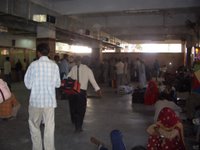 Nous avons encore patienté après avoir fait 4 fois le tour de la gare pour trouver le bon guichet. Et enfin, nous avons eu nos fameux tickets bien mérités !
Nous avons encore patienté après avoir fait 4 fois le tour de la gare pour trouver le bon guichet. Et enfin, nous avons eu nos fameux tickets bien mérités !
Après tout ce stress, nous avons enfin pu aller visiter le city palace,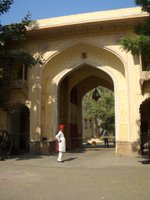 demeure actuelle du maharajah et sa famille. Ce gigantesque palais comprend différents petits palais. Admirez...
demeure actuelle du maharajah et sa famille. Ce gigantesque palais comprend différents petits palais. Admirez...


Ensuite, nous avons admiré le plus célèbre monument de Jaipur : le Palais des Vents. Il s'agit d'une façade d'environ 3 cm d'épaisseur. Elle a été construite en 1799 de telle sorte que le vent puisse y circuler afin de rafraîchir l'atmosphère. Son côté pyramidal à plusieurs étages permettait aux femmes du harem d'observer dans être vues.
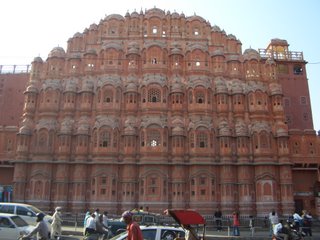
 On the way to Agra
On the way to Agra
Les cours se sont terminés à 13h30, vendredi. Le week-end peut donc commencer. Nous avons décidé d'aller découvrir quelques lieux incontournables de l'Inde.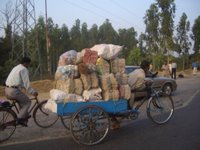 Nous sommes donc partis en fin d'après-midi en direction de la ville d'Agra, célèbre pour son fameux palais : le Taj Mahal.
Nous sommes donc partis en fin d'après-midi en direction de la ville d'Agra, célèbre pour son fameux palais : le Taj Mahal.
Nous avons embarqué à 9 dans une voiture avec chauffeur suivie d'une autre voiture de 4 personnes. Nous étions donc assez serrés mais l'ambiance était assez cool.Il faut rappeler que les conditions de sécurité en voiture sont peu ou complètement inexistantes. En effet, il n'y a pas de ceintures de sécurité, il n'y a aucun panneau de signalisation, le code de la route n'existe pas et chacun conduit comme il l'entend. Autant dire que le danger est maximal sur les routes indiennes surtout la nuit sans éclairage et avec les pleins phares des voitures ou camions venant en sens inverse.
En Inde, on conduit à gauche. Les doublements par la droite sont atroces et le nombre d'accidents est faramineux. Autant dire que je n'ai jamais eu autant peur en voiture que ce week-end.
Après plus de 5h de route pour faire 250kms entre Gurgaon et Agra, nous sommes enfin arrivés à bonne destination dans un petit hôtel situé à 100 mètres de la porte Est du Taj Mahal.
Agra : Sunrise on the Taj Mahal
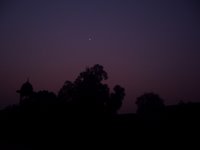 Le réveil matinal à 5h du matin pour admirer le lever du soleil sur le Taj Mahal en valait bien le coup. La porte Est ouvre à 6h, heure où il fait encore nuit. Quand je suis rentrée dans le site, la pénombre était encore présente. J'ai aperçu le palais dans le noir puis j'ai attendu tranquillement que le spectacle commence.
Le réveil matinal à 5h du matin pour admirer le lever du soleil sur le Taj Mahal en valait bien le coup. La porte Est ouvre à 6h, heure où il fait encore nuit. Quand je suis rentrée dans le site, la pénombre était encore présente. J'ai aperçu le palais dans le noir puis j'ai attendu tranquillement que le spectacle commence.
C'était absolument magnifique de pouvoir découvrir ce monument sous différentes teintes.

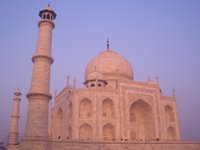
Le Taj Mahal est la 7ème merveille du monde. Ce palais fut construit en 1631 par l'empereur Shah Jahan. Il est LE symbôle de l'amour éternel : il a dédié ce palais à son amour qu'il a perdu.
La mort de son épouse Mutaz Mahal, dotée d'une beauté légendaire, laissa le coeur du souverain complètement dévasté. Fou de chagrin, il décida de construire un édifice à sa mémoire et à l'image de son amour. Pour construire ce monument, il a fallut 22 ans de labeur et plus de 20000 artisans.
Ce palais est symétrique. Les 4 tours ont été construites pour donner la perspective du monument.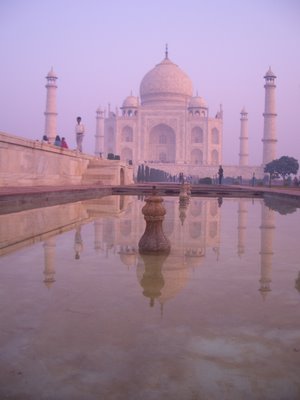
Agra : The Red Fort
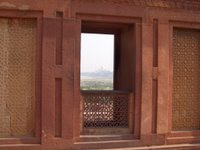
Après le palais de l'Amour, place au fort rouge et à la richesse. Quatre générations d'empereur se sont succédées pendant près de 95 ans. Le fils de Shah Jahan qui contruisit le Taj, décida d'emprisonner son père dans ce fort pour régner à sa place.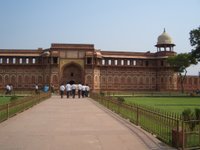 Pendant huit ans, le vieil homme put contempler de sa fenêtre, son admirable chef d'oeuvre où reposait sa bien aimée. Les piliers incrustés de pierres précieuses et les mosaîques de toutes les couleurs lui donnent des airs de palais.
Pendant huit ans, le vieil homme put contempler de sa fenêtre, son admirable chef d'oeuvre où reposait sa bien aimée. Les piliers incrustés de pierres précieuses et les mosaîques de toutes les couleurs lui donnent des airs de palais.
On the way to Jaipur : Fatehpur Sikri Fatehpur Sikri est une petite ville entre Agra et Jaipur. Nous en avons donc profité pour nous y arrêter en chemin pour visiter la citadelle. Elle a été construite par l'empereur Akbar en 1572 pour y installer sa cour. L'architecture est similaire à celle du Red Fort mais en plus baroque. La fantaisie de ce momunment vient du fait du mixage des différentes religions : hindu, muslim, catholic and jaine.
Fatehpur Sikri est une petite ville entre Agra et Jaipur. Nous en avons donc profité pour nous y arrêter en chemin pour visiter la citadelle. Elle a été construite par l'empereur Akbar en 1572 pour y installer sa cour. L'architecture est similaire à celle du Red Fort mais en plus baroque. La fantaisie de ce momunment vient du fait du mixage des différentes religions : hindu, muslim, catholic and jaine.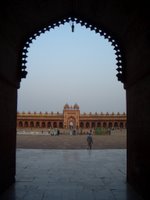
Nous avons eu le temps de faire un tour rapide et de voir les différents tombeaux et la mosquée qui sont à l'intérieur de cet édifice.
The shopping hotspots in Varanasi are Chowk, Gyan Vapi, Vishwanath Gali, Thatheri Bazar, Lahurabir, Godoulia or Dashswamedh Gali and Golghar. Besides the illustrious and fine silks and brocaded fabrics, one can also buy shawls, carpets, wall hangings...
When you enter a silk shop, the owner will offer you a masala tea and then he will show you all the silk scarfs he has in his shop ! All of them are very colourful, you can't even choose one because there are so many different styles, colours, sizes... It's like the 1001 nights or Alibaba palace. Completely amazing !

Ganges baths

Very early in the morning, at about six o'clock, hindu people take their bath in the
 Ganges river to purify themselves.
Ganges river to purify themselves.It will purify the soul from sins and is an important step on the way to an ultimate goal - the Nirvana, which means the salvation from the cycle of birth, death and rebirth and ultimately to be one with the almighty God, the creator.
Varanasi also is a favorite place to die, for hindus believe, that one who dies at Varanasi gains emancipation automatically, such is the greatness of this shrine! That's why there are ritual cremations on pyres from Sandle wood and in crematoria each night. All hindus desire, that no matter where they die, at least their ashes be merged in the pious waters of mother Ganga who in Hindu's belief in her immense love for her children will bring emancipation from the trauma of the cycle of birth and death!

The PUJA

 Every evenings, Hindu people perform the "Puja" with lighted lamps.
Every evenings, Hindu people perform the "Puja" with lighted lamps.They offer candles to the Ganges while musicians are playing music and siging holy words.
The ambience is spectacular and very spirituous.
Tuesday, December 12, 2006
Day 21 : Sarnath
 Sarnath is the city where Buddha preached his first discourse in the deer park to set in motion the 'Wheel of the Dharma'. It is one of the most holy sites as in this place the stream of the Buddha's teaching first flowed.
Sarnath is the city where Buddha preached his first discourse in the deer park to set in motion the 'Wheel of the Dharma'. It is one of the most holy sites as in this place the stream of the Buddha's teaching first flowed. At this place, the Buddha encountered the five men who had been his companions of earlier austerities. On meeting the enlightened Buddha, all they saw was an ordinary man. "Here comes the mendicant Gautama," they said, "who has turned away from asceticism. He is certainly not worth our respect." When they reminded him of his former vows, the Buddha replied, "Austerities only confuse the mind. In the exhaustion and mental stupor to which they lead, one can no longer understand the ordinary things of life, still less the truth that lies beyond the senses. I have given up extremes of either luxury or asceticism. I have discovered the Middle Way". Hearing this the five ascetics became the Buddha's first disciples.
Gautama Buddha started teaching not to debate but for the advantage of and out of compassion for human beings. He explained the middle way which avoids extremes, the Four Noble Truths, and prescribed the Eight-fold path. The Four Noble Truths are: 1. There is suffering; 2. Suffering has a cause; 3. The cause is removable, and 4. There are ways to remove the causes. So as to remove the causes the Buddha prescribed an Eight-fold Path: Right speech, Right action, Right livelihood, Right effort, Right mindfulness, Right concentration, Right attitude and Right view.
The Dhamekha Stupa
This is the most conspicuous structure at Sarnath. Colonel Cunningham bore a shaft from the top centre of the stupa and discovered a stone tablet on which an inscription is written with the word Dhamekha, and mentions that this is the spot where the Buddha delivered his first sermon. Dhamekha seems to be a distorted form of Dharma Chakra which means turning the wheel of the Dharma. It is also said that at this spot the five ascetics who left Gautama Buddha in Bodh Gaya used to live in huts. The original stupa was constructed by Ashoka. The present size of the stupa is 31.3 m high and 28.3 m in diameter. The lower portion of the stupa is covered completely with beautifully carved stones. The design consists of a broad band of Swastika (fylfot) carved in different geometrical patterns with a finely chiselled lotus wreath, running over and below the swastikas.
The Dhamekha stupa is considered to be the sacred place where the voice of Buddhism was first heard. Many dignitaries of Buddhist countries visit this place for circumambulation of this sacred stupa and to worship the Buddha. Tibetans Buddhist circumambulate it chanting the mantra 'Om mani padme hum'. The first discourse of the Buddha was on the 'Wheel of Law'. The wheel symbolises samsara (world), the eternal round of existence which goes on and on, life after life because of ceaseless cravings and desire. Wednesday, December 06, 2006
Day 20 : Varanasi or Benaras also known as Kashi
 Varanasi is one of the oldest cities in the world : more than 3000 years old.
Varanasi is one of the oldest cities in the world : more than 3000 years old.It is a Holy and worship place for Hindu people : same as the Vatican for the Catholics or the Mecca for the Muslims. Moreover, this city is THE one which reflect the most the real Indian culture and the power of Hinduism.
Every year, more than one million pilgrims come to have a bath in the Ganga.
 It is believed by Hindus that bathing in the river Ganga results in remission of sins and that dying in the holy city of Kashi (Varanasi) circumvents rebirth.
It is believed by Hindus that bathing in the river Ganga results in remission of sins and that dying in the holy city of Kashi (Varanasi) circumvents rebirth.
Walking on the ghâtsWalking on the Ganga ghâts, we met different people having a bath, cleaning and drying their clothes. The atmosphere is very quiet and peaceful.

Day 14 : Back to Jodhpur
 The Clock Market
The Clock MarketThe clock tower is the central point of Jodhpur.
There is a big market standing around the clock : spices, fruits & vegetables, clothes, varieties of seeds (corn, lentil, rice...) & lots of other things... The tower was built in 1910 by Maharajah Sardar to give the time to inhabitants. That's why the market is called the Sardar Market.


Umaid Bhawan Palace
We also visited the Umaid Bhawan Palace where the Maharajah of Jodhpur is living at the moment. This monument has got three different parts :
1- The Maharajah & his family house
2- A Palace Hotel part of Taj Resort which is a famous Indian Hotel Brand all over the country.
3- The museum

Having fun in the small blue streets of the old city

We met very nice indian people walking in these very tight streets.
We also had Masala tea with old men and tried to discuss with them because they couldn't speak english.
Masala tea is the most popular drink in India. It's tea with milk, cardamon & ginger. First, you boil the milk twice, then you had Chai tea, the spices and sugar. This is a very good hot drink and you can find it wherever you want.

Tuesday, December 05, 2006
Day 13 : Going to Osian
Temples
On the way to Osian, a small town near Jodhpur in the desert, we visited Hindu and Jain temples.


The desertIn Osian desert, we had a fun camel ride et just looked at the beauty of such a landscape.



The Camel Camp

Then, after the ride, we took a break in an oasis lost in nowhere in the desert called the camel camp. We had a nice lunch and rested in this beautiful and luxuous place.

Tuesday, November 28, 2006
Day 12 : Jodhpur

We arrived in Jodhpur at about 10 in the morning.
A driver took us at the station and we went to our Hotel Ratan Villas.
It was a nice colonial house built in the 1920s.
The owners were very kind and they were the fifth generation living in this house.
Mehrangarh Fort or the Citadel of the Sun

 Then, we decided to visit the fort. It was constructed in 1459 like a real eagle nest by the founder of Jodhpur: rao Jodha who gave the name of Jodhpur. The fundation is dominating the town at 135 meters above the city ; its width is 250 meters.
Then, we decided to visit the fort. It was constructed in 1459 like a real eagle nest by the founder of Jodhpur: rao Jodha who gave the name of Jodhpur. The fundation is dominating the town at 135 meters above the city ; its width is 250 meters.Mehrangarh (meaning Majestic Fort) is one of the largest forts in India.
Maharajahs lived there until the 20th century and then go the Umaid Bhawan Palace (I will talk about it later).

Battle scars of canon ball hit by attacking armies of Jaipur can still be seen on the second gate. To the left is chhatri of Kirat Singh Soda, a soldier who fell on the spot while defending the fort against the armies of Amber.
There are seven gates, which include Jayapol meaning victory built by Maharaja Man Singh to commemorate his victories over Jaipur and Bikaner armies. Fattehpol also meaning victory gate was built by Maharaja Ajit Singh to mark the defeat of Mughals. The palm imprints still attract devotional attention and are covered by vermilion paste and paper-thin silver foil.
We took the audio guide to have the whole story of this fort.

The blue city
Jodhpur is the second largest city in the Indian state of the Rajasthan. Jodhpur is a popular
 destination, featuring many beautiful palaces, forts and temples, apart from a stark, scenic desert landscape. The city is known as the "Sun City" for the bright, sunny weather it enjoys all year. It is also referred as the Blue City, due to the indigo tinge of the whitewashed houses around the Fort. Jodhpur is also known for gentleness of its people. The old city of Jodhpur is surrounded by a thick stone wall. The wall has six huge gates called Nagauri gate, Merati gate, Sojati gate, Jalori gate, Siwanchi gate and Chand pol.
destination, featuring many beautiful palaces, forts and temples, apart from a stark, scenic desert landscape. The city is known as the "Sun City" for the bright, sunny weather it enjoys all year. It is also referred as the Blue City, due to the indigo tinge of the whitewashed houses around the Fort. Jodhpur is also known for gentleness of its people. The old city of Jodhpur is surrounded by a thick stone wall. The wall has six huge gates called Nagauri gate, Merati gate, Sojati gate, Jalori gate, Siwanchi gate and Chand pol.
Day 11 : Going to the Rajasthan
On the way to Jodhpur

We had a 4 day week-end from Thursday night to Tuesday morning...
So we decided to go far away in the Rajasthan. We took the night train at Old Delhi Station in category 3 AC (that means the 3rd class with Air Conditionning).
Indian trains have 5 different categories : First, Second AC, Third AC, sleeper and general.
It is funny because the names are written on a paper and you have to check your when you get in the train. In our coach, there were 6 + 2 beds. It's enough comfortable: you have cloths, blanquets & pillow.
We had a nice dinner: we brought a "saucisson sec", some olives, crisps and fresh vegetables.

Day 10 : Visiting Hero Honda
 On wenesday afternoon, we had the opportunity to
On wenesday afternoon, we had the opportunity to  visit an Indian plant : Hero Honda.
visit an Indian plant : Hero Honda.In a little over two decades, the world's largest manufacturer of bicycles and the global leader in motorcycles have created not only the world's single largest motorcycle company but also the most endearing and successful joint venture for Honda Motor Company worldwide.
They manufacture 6500 motorcycles every day : one bike is made every 3 seconds ! It was really interesting to see the assembly line which is very modern and has great technologies.
Day 7 : Week-end time
Jaipur
Notre dernière journée à Jaipur a été pleine d'émotions. Nous avons repris notre taxi pour aller visiter la ville et le palais du Maharajah de Jaipur. Mais l'ennui, c'est qu'à peine installer dans la voiture, notre chauffeur sentait l'alcool et été complètement à l'ouest. Et pour couronner le tout, nous avons eu un mini accident avec l'autre chauffeur qui nous suivait avec 4 potes en plein milieu d'un énorme rond-point où tout le monde klaxonnait, criait !!! La foire !! Les flics étaient là... Constat, perte de temps et compagnie...

Nous avons dû prendre une rapide décision pour la suite vu que nous avions déjà perdu 1h30 avec tout ce cinéma. Nous avons choisi de payer notre taxi driver et de nous rendre le plus vite possible à la gare pour aller prendre des billets de train pour notre retour l'après-midi !
 Nous avons encore patienté après avoir fait 4 fois le tour de la gare pour trouver le bon guichet. Et enfin, nous avons eu nos fameux tickets bien mérités !
Nous avons encore patienté après avoir fait 4 fois le tour de la gare pour trouver le bon guichet. Et enfin, nous avons eu nos fameux tickets bien mérités !Après tout ce stress, nous avons enfin pu aller visiter le city palace,
 demeure actuelle du maharajah et sa famille. Ce gigantesque palais comprend différents petits palais. Admirez...
demeure actuelle du maharajah et sa famille. Ce gigantesque palais comprend différents petits palais. Admirez...

Ensuite, nous avons admiré le plus célèbre monument de Jaipur : le Palais des Vents. Il s'agit d'une façade d'environ 3 cm d'épaisseur. Elle a été construite en 1799 de telle sorte que le vent puisse y circuler afin de rafraîchir l'atmosphère. Son côté pyramidal à plusieurs étages permettait aux femmes du harem d'observer dans être vues.

Monday, November 20, 2006
Days 5 & 6 : Week-end time
 On the way to Agra
On the way to AgraLes cours se sont terminés à 13h30, vendredi. Le week-end peut donc commencer. Nous avons décidé d'aller découvrir quelques lieux incontournables de l'Inde.
 Nous sommes donc partis en fin d'après-midi en direction de la ville d'Agra, célèbre pour son fameux palais : le Taj Mahal.
Nous sommes donc partis en fin d'après-midi en direction de la ville d'Agra, célèbre pour son fameux palais : le Taj Mahal.Nous avons embarqué à 9 dans une voiture avec chauffeur suivie d'une autre voiture de 4 personnes. Nous étions donc assez serrés mais l'ambiance était assez cool.Il faut rappeler que les conditions de sécurité en voiture sont peu ou complètement inexistantes. En effet, il n'y a pas de ceintures de sécurité, il n'y a aucun panneau de signalisation, le code de la route n'existe pas et chacun conduit comme il l'entend. Autant dire que le danger est maximal sur les routes indiennes surtout la nuit sans éclairage et avec les pleins phares des voitures ou camions venant en sens inverse.
En Inde, on conduit à gauche. Les doublements par la droite sont atroces et le nombre d'accidents est faramineux. Autant dire que je n'ai jamais eu autant peur en voiture que ce week-end.
Après plus de 5h de route pour faire 250kms entre Gurgaon et Agra, nous sommes enfin arrivés à bonne destination dans un petit hôtel situé à 100 mètres de la porte Est du Taj Mahal.
Agra : Sunrise on the Taj Mahal
 Le réveil matinal à 5h du matin pour admirer le lever du soleil sur le Taj Mahal en valait bien le coup. La porte Est ouvre à 6h, heure où il fait encore nuit. Quand je suis rentrée dans le site, la pénombre était encore présente. J'ai aperçu le palais dans le noir puis j'ai attendu tranquillement que le spectacle commence.
Le réveil matinal à 5h du matin pour admirer le lever du soleil sur le Taj Mahal en valait bien le coup. La porte Est ouvre à 6h, heure où il fait encore nuit. Quand je suis rentrée dans le site, la pénombre était encore présente. J'ai aperçu le palais dans le noir puis j'ai attendu tranquillement que le spectacle commence.C'était absolument magnifique de pouvoir découvrir ce monument sous différentes teintes.


Le Taj Mahal est la 7ème merveille du monde. Ce palais fut construit en 1631 par l'empereur Shah Jahan. Il est LE symbôle de l'amour éternel : il a dédié ce palais à son amour qu'il a perdu.
La mort de son épouse Mutaz Mahal, dotée d'une beauté légendaire, laissa le coeur du souverain complètement dévasté. Fou de chagrin, il décida de construire un édifice à sa mémoire et à l'image de son amour. Pour construire ce monument, il a fallut 22 ans de labeur et plus de 20000 artisans.
Ce palais est symétrique. Les 4 tours ont été construites pour donner la perspective du monument.

Agra : The Red Fort

Après le palais de l'Amour, place au fort rouge et à la richesse. Quatre générations d'empereur se sont succédées pendant près de 95 ans. Le fils de Shah Jahan qui contruisit le Taj, décida d'emprisonner son père dans ce fort pour régner à sa place.
 Pendant huit ans, le vieil homme put contempler de sa fenêtre, son admirable chef d'oeuvre où reposait sa bien aimée. Les piliers incrustés de pierres précieuses et les mosaîques de toutes les couleurs lui donnent des airs de palais.
Pendant huit ans, le vieil homme put contempler de sa fenêtre, son admirable chef d'oeuvre où reposait sa bien aimée. Les piliers incrustés de pierres précieuses et les mosaîques de toutes les couleurs lui donnent des airs de palais.On the way to Jaipur : Fatehpur Sikri
 Fatehpur Sikri est une petite ville entre Agra et Jaipur. Nous en avons donc profité pour nous y arrêter en chemin pour visiter la citadelle. Elle a été construite par l'empereur Akbar en 1572 pour y installer sa cour. L'architecture est similaire à celle du Red Fort mais en plus baroque. La fantaisie de ce momunment vient du fait du mixage des différentes religions : hindu, muslim, catholic and jaine.
Fatehpur Sikri est une petite ville entre Agra et Jaipur. Nous en avons donc profité pour nous y arrêter en chemin pour visiter la citadelle. Elle a été construite par l'empereur Akbar en 1572 pour y installer sa cour. L'architecture est similaire à celle du Red Fort mais en plus baroque. La fantaisie de ce momunment vient du fait du mixage des différentes religions : hindu, muslim, catholic and jaine.
Nous avons eu le temps de faire un tour rapide et de voir les différents tombeaux et la mosquée qui sont à l'intérieur de cet édifice.


